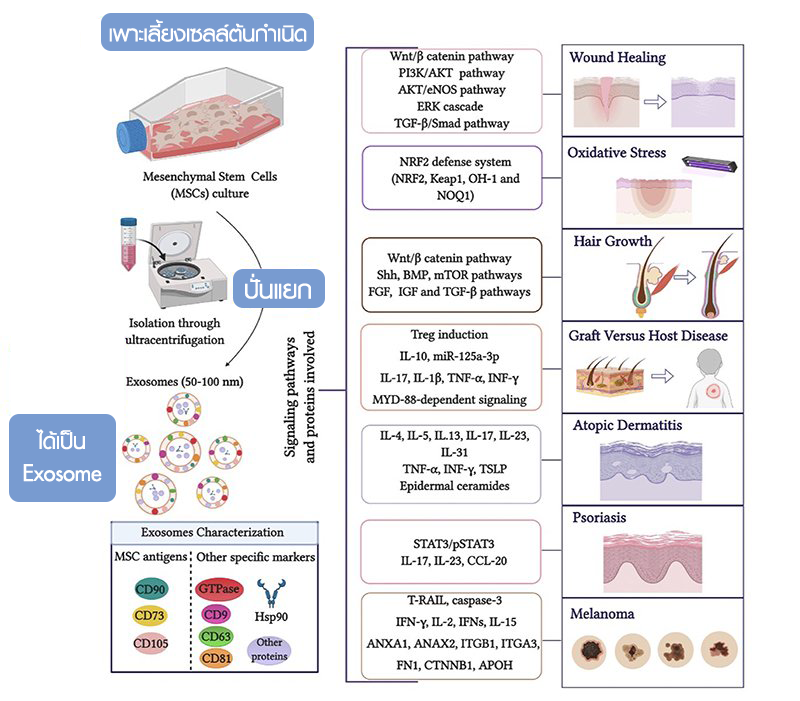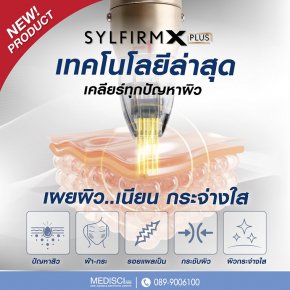Exosome: Innovation for Skin cell Regeneration

What is Exosome?
Exosome is a nano-sized extracellular vesicle (EV) that is 30-150 nm in size. It can be found in all body fluids. including plasma, serum, saliva, cerebrospinal fluid, urine, and cell culture media. Exosomes are composed of various biomolecules, including nucleic acids, proteins, lipids, and metabolites, which play an important role in cell-to-cell communication as well.
Exosomes are cells that contain small nanoparticles. Thus, enabling the cells to repair and regenerate cells in the degenerative area that is deep down to the level of gene expression (Epigenetic) as well as helping to resist inflammatory mechanisms of cell stress. Moreover, it also helps to slow down the deterioration as well.

Working Principle
Exosome is the use of various biomolecules directly into the cell, using this bag as an intermediary. The cells use the contents of this bag like a message in a letter, which is packed and sent out to tell other cells to recognize which will move back and forth between Skin cells involved in turnover causing skin metabolism.
The creation of fibroblasts that produce collagen and elastin. And has antioxidant activity that prevents the formation of skin cells and cell deterioration. It has the effect of helping to deliver disease-related drug components to cells. To aid in the regeneration and repair of tissue functions such as promoting cell proliferation and wound healing.

The Benefits of Exosome
- Wound Healing
- Skin Imbalance of Free Radicals. and Aging Restoration (Oxidative Stress)
- Hair Growth
- GVHD (Graft Versus Host Disease) Prevention
- Atopic Dermatitis Protection
- Psoriasis Resistance
- Abnormal Skin Pigmentation Healing

1. Wound Healing
Exosome promotes angiogenesis cell migration, cell proliferation (proliferation), and the process of creating new epithelium (re-epithelialization) which can help reduce scarring In the early stages of wound healing, collagen production is increased. At the end of wound healing, collagen production is inhibited. and reduce the accumulation of myofibroblasts which has the ability to shrink thus reducing the chances of scarring
Wound healing is a complex process of tissue regeneration and function, related to the work of many things both maintaining balance homeostasis, inflammation, cell migration, and regeneration angiogenesis and rearrangement of newly created tissues which is controlled by many biomolecules that enter the skin
2. Skin Aging Restoration
Studies have shown that exosomes which are derived from stem cells can not only restore skin by preventing oxidative stress and photo-aging, but also stimulates the production of collagen.
Oxidative stress from UV is the main factor that can cause skin problems. This causes the lipid, protein, and DNA layers in the skin to produce more ROS and reduce the activity of antioxidants. This results in sunburn, premature aging, and cancer.

3. Hair Growth
Hair loss is a common problem and has a bad effect on people. There are many factors that cause hair loss, such as hormonal changes. malnutrition And using certain drugs, etc. Currently, finasteride and minoxidil are the main treatments for hair loss, but this treatment has been found to be effective only in the short term. And if the treatment is stopped, it will cause rapid hair loss.
The hair life cycle is a complex process, consisting of three stages: growth (anagen), stopping (catagen), and resting (telogen). Hair grows from basal cells called dermal papilla (DP) at the hair's root. and plays an important role in the hair cycle Studies have shown that the exosome promotes DP formation and hair growth. Made my hair come back to be black and beautiful as well.
4. GVHD Prevention
GVHD (Graft Versus Host Disease) is caused by donor cells attacking/attacking donor cells This is a common reaction in organ transplant patients. In the acute phase, a rash appears. Long-term effects can affect tissues and organs.
Stem cell transplantation can cause GVHD, with long-term effects on other illnesses. And if severe, it can cause death.
Exosomes can protect against long-term GVHD by regulating the activity of T17/Treg, a key player in inflammation. In addition, the exosome promotes tissue repair and homeostasis. (homeostasis)
Exosomes are secreted by both immune cells. and non-immune cells Song can stimulate and suppress the immune system. The effect of exosomes on the immune system is T-cell activation, immune system suppression, anti-inflammatory

5. Atopic Dermatitis Protection
An uncontrolled chronic inflammatory response is associated with various inflammatory diseases, including skin allergies such as atopic dermatitis, which are related to the immune system, exosomes are therefore important in controlling inflammation and treating allergies.
AD is a chronic skin disease. With rashes and red spots all over the body and inflammation throughout the body, AD is related to genetics. immune system and environmental factors in the past few years, more and more living people have been found.
Elevated T2 cytokine levels have been associated with an abnormal response to the immune system. This leads to more susceptibility to AD. The expression of genes that protect the epidermis is also an important factor in the development of AD.
There are many mechanisms of AD, such as the outer skin barrier that acts as a protective (skin barrier) has changed. causing the skin to become very inflamed germs and foreign matter can get inside, the immune system sends abnormal signals to the epidermis, decreasing ceramides, filaggrin, and antimicrobial peptides.
Exosomes can enhance the skin barrier function by increasing ceramides and reducing the immune response during disease exacerbations. Exosomes stimulate the production of ceramides in the epidermis. and help create a line to prevent foreign matter from permeating into the inside

6. Psoriasis Resistance
Psoriasis is one of the most common skin diseases. It is a chronic skin disease that can be found in various parts of the body such as elbows, knees, nails, or scalp, caused by the thick outer layer of skin cells that are increasing in number and in the formation of new blood vessels and immune system problems
The main factors that cause this disease are the immune system and genetics. There are various treatments aimed at reducing skin symptoms. Exosomes have been used to treat psoriasis and have not relapsed for 4-5 years.
As mentioned above, exosomes have been shown to contribute to the reduction of abnormal inflammation. Like the treatment of AD and GVHD, many studies have shown that can inhibit immune dysfunction by regulating the function of immune cells inhibits the activity of cytokines involved in inflammation
A 2020 study by Zhang Y. et al. found that exosomes can prevent disease progression. and inhibiting the severity of psoriasis by regulating the activity of immune cells inhibits the activity of cytokines involved in inflammation, reducing symptoms and immune system response.
7. Abnormal Skin Pigmentation Healing
In the study, Tumor necrosis factor-related apoptosis-inducing ligand (TRAIL) is a part of TNF involved in cancer therapy. DR4 and receiver5; DR5 of cancer cells)
TRAIL-derived exosome treatment can induce apoptosis of cancer cells. including lung, tracheal, kidney, breast, and nervous tissue cancers (Neuroblastoma) with greater efficacy compared to TRAIL alone.

The Benefits
Because of being non-surgical treatment or other combined treatments, exosome can give some benefits, such as
- No serious side effects
- No recovery
- See the treatment results quite quickly. Just treatment in 1-3 times or up to the doctor's assessment.
- Can be done along with existing hair treatment methods
Suitable For:
- Those who want to make their skin look younger
- Those who have problems with pigmentation
- Patients with allergies and inflammation of the skin
- Someone who wants to treat wounds and acne scars
- Psoriasis patient
สอบถามรายละเอียดเพิ่มเติม
- Call-center : 089-9006100
- สำนักงานใหญ่ (งามวงศ์วาน) : 02-954-9440
- สาขาราชพฤกษ์ : 02-863-8765
- สาขาสุขุมวิท39 : 02-259-6992
- Line : @MEDISCI
Maria I. Quinones-Vico et. Al. The Role of Exosomes Derived From Mesenchymal Stromal Cells in Dermatology. Frontiers in Cell and development Biology, 2021.






